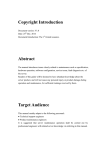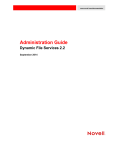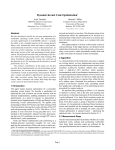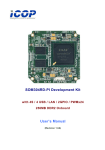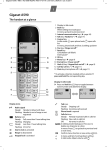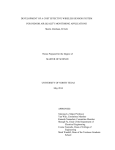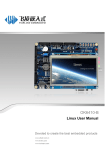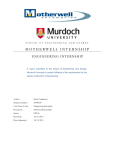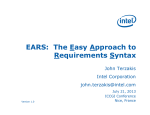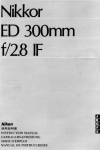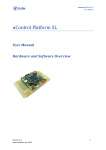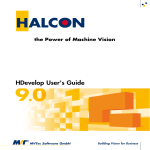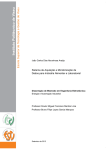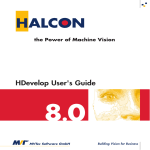Download A Bare Machine Sensor Application for an ARM Processor
Transcript
A Bare Machine Sensor Application for an ARM Processor Alexander Peter, Ramesh K. Karne and Alexander L. Wijesinha Department of Computer & Information Sciences Towson, MD 21252 [email protected], (rkarne, awijesinha)@towson.edu Abstract- Sensor devices that monitor environmental changes in temperature, sound, light, vibration and pressure usually run applications that require the support of a small operating system, lean kernel, or an embedded system. This paper presents a methodology for developing sensor device applications that can be directly run on the bare hardware without any need for middleware. Such bare sensor device applications only depend on the underlying processor architecture, enabling them to run on a variety of devices. The methodology is used for developing, designing, and implementing a temperature sensor application that runs on an ARM processor. The same methodology can be used to build other bare machine sensor device applications for ARM processors, and is easily extended to different processor architectures. Keywords-bare machine computing,sensor devices, architecture, application objects, direct hardware API. ARM I. INTRODUCTION The popular ARM processor is used in mobile phones, sensor devices, and other control applications. These applications typically use an operating system (OS), lean kernel, or they are part of an embedded system [1]. We describe a methodology to develop bare ARM applications, where the application directly communicates to hardware without any middleware or OS. Previously, a variety of bare PC applications have been built [2, 3, 4, 5, 6]. These applications are based on the Bare Machine Computing (BMC) paradigm, which was originally called the Dispersed Operating System Computing (DOSC) paradigm [7]. The BMC paradigm allows an application programmer to have sole control of the application and its execution environment. When computing devices or hardware system is bare, it could become ownerless, pervasive, adaptable, and reconfigurable to suit the needs of an application. The bare hardware or system can be used by any user anywhere without concern for sharing resources. A portable device such as a USB flash drive can be used to carry the bare machine application and run it on any bare machine. The BMC paradigm enables computing to be polarized on applications rather than computing environments. This paper describes the approach and methodology used to build a bare machine ARM application for a sensor device. The methodology is illustrated by means of a temperature sensor application that runs on an ARM development board (ADB) [8]. We use U-Boot, the Universal Boot Loader, to load and run the bare application. The U-Boot is the only tool needed to bootstrap and load the application, which is independent of any operating system, lean kernel, or embedded system. In order to build a bare machine temperature sensor device application, it requires several components as shown in Fig. 1. A brief functional description of this application is as follows. The application is loaded from the SD Card interface (Label 9) into memory using U-Boot. A temperature sensor (Label 1) is plugged into the ADB to monitor the current room temperature with a sensing granularity of 900 microseconds. As the temperature changes, its value (Label 8) and a graphic image (Label 7) is displayed on the LCD screen (Label 2). An output console is used to debug the inner working of the ADB and temperature (Label 3). An LED light (Label 4) provides a visual indication of temperature sensor operation. A buzzer (Label 5) is used to trigger an auditory alert based on a predefined temperature threshold. Also, the LCD screen color is changed to red to provide a visual alert, with a button icon to disable the buzzer via a touch screen interface (Label 6). The ADB is used to illustrate the development of a bare temperature sensor device application without any middleware or kernel. The rest of the paper is organized as follows. Background and related work is presented in Section II. A development methodology for building bare machine applications for ARM sensors is described in Section III. The design, implementation,and interface details together with code snippets are provided in Section IV. Functional operation and testing is discussed in Section V. The conclusion is contained in Section VI. Bare Application (8) UART/Console RS232 (3) Touch Screen (6) Bare Graphics (7) LED (4) LCD (2) Buzzer (5) Temperature Sensor (1) SD Card (9) Fig. 1. ARM Development Board (ADB) 978-1-4673-5208-6/13/$31.00 ©2013 IEEE II. BACKGROUND AND RELATED WORK Most computer applications require OS calls in some form. These OS calls enable applications to access hardware resources at run time. In contrast, bare machine applications eliminate the OS by using their own bare interfaces to the hardware [9]. These interfaces may, for example, enable program load, screen display, mouse and keyboard access, process management, and network or audio card control. A given application only includes the interfaces that it needs. By eliminating the OS, kernel, and all forms of intermediary system software, the application is given full control of the hardware. Details of a bare graphics application for an ARM processor are given in [10]. In this paper, we describe a bare application for a sensor device that runs on an ARM processor. Many approaches to eliminate OS abstractions or reduce OS overhead have been proposed beginning with Exokernel [11]. OS-Kit [12] provides the components to build an OS,while Tiny OS [13] is designed for sensor applications. Palacios [14] is an example of a lean kernel. Translating x86 code to run on ARM processors is the focus of [15]. In [16, 17], the Java virtual machine is run directly on hardware in an embedded system. BulkCompiler [18] is a simple compiler layer that works with ISA primitives and software algorithms. The BMC approach differs from previous code transformation/translation approaches in that it is based on eliminating OS or kernel dependent code in applications. This approach still has a dependency on the underlying architecture. This dependency could be eliminated in the future by developing a generic hardware API for various architectures, and eventually including these interfaces in the hardware. However, until the hardware API is standardized, the BMC approach requires that the programmer write both application and systems code as an integral part of an application. III. METHODOLOGY A general high-level methodology for building bare machine sensor device applications is shown in Fig. 2. This methodology was used to construct the bare sensor ARM application discussed in this paper. To build any bare sensor ARM application, it is necessary to understand the various ARM architecture interfaces and protocols such as GPIO (General Purpose Input and Output), UART, USB, SPI, IC2 and SDIO. This involves both system and application level programming as when building any bare application. In particular, internal details, PIN configurations, and other lowlevel information obtained from the product datasheet are needed to construct the appropriate bare interfaces for the ARM sensor application. Also, an appropriate development and hardware execution environment needs to be chosen to build, test and debug bare applications since there is no OS support. In some cases, an integrated development environment may help to speed up the bare application development process. Based on the type of sensor device, appropriate ARM interfaces (GPIO, UART, USB, etc.) must be selected to implement a given application. Furthermore, a generic ARM API must be developed to make the applications robust. In addition, an appropriate compiler and linker for the programming language must be available to create the bare application modules. Sensor application testing and validation are especially challenging in a bare environment. START Understand peripheral protocol and interfaces to ARM Architecture (GPIO, UART, USB, SPI, IC2 and SDIO) Understand product spec/data sheet for a given sensor device Identify sensor device pin configuration that are relevant to ARM Architecture peripheral protocol Select a bare ARM sensor device platform for development (ADB - ARM Development Board) Identify ARM interfaces that are needed for this sensor device Design ARM interfaces API for the above interfaces Design and implement sensor device application using the above API Test and validate the sensor device application END Fig. 2.Bare machine sensor development methodology Details of the bare sensor application that was built using this methodology are as follows. We selected a temperature sensor device, specifically the model DS18B20U 1-Wire Digital Thermometer [19], which has three leads (GND, DQand VDD). The Samsung OK6410 ARM Development Board [8] was used as the development platform. The sensor device is plugged into ARM’s GPIO interface. The GPIO API is needed to initialize and communicate with the GPIO controller. A timer facility on the ADB is used to sample the sensor device since it requires a timer API for this application. Similarly, it is necessary to construct an API for the touch screen (user interface, disable alerts), LCD (display, visual) [20], UART/RS232 (console debugging), LED Controller (monitoring sensor device), and buzzer (alert). While this methodology is specific to the temperature sensor ARM device, it can be modified easily for other applications. Developing bare machine applications poses many challenges as indicate above, since the programmer defines, architects and implements all the necessary hardware interfaces needed for the application. There is no middleware or OS/kernel of any kind to support the application during execution. This is different from developing conventional OS-based applications. IV. DESIGN/IMPLEMENTATION AND INTERFACES This section describes the interfaces required, its design and implementation for the bare temperature sensor device application. A. Interfaces Fig. 3 identifies the interfaces needed for developing a bare temperature sensor device application. This figure illustrates how the software API and external peripherals communicate with the internal hardware. In this application, the software API was designed and implemented for Touch-Screen, LCD Display, UART/RS232, Timer, LED, Buzzer, and Thermometer Sensor Device. The figure also indicates the actual interfaces designed and implemented for each class of API (e.g. LCD display (init(), clock_cycle(), write_frame()). We designed and implemented 20 software APIs for this application. Internal Hardware Samsung OK6410 ADB GPIO BANK Software API init, polling, read_touch() ADC GPIO_F Touch Screen init, clock_cycle, write_frame() GPIO_I GPIO_J GPIO_F LCD Display init, read, write char () LCD Display UART/RS232 PWM – prescaler GPIO_F Timer init, read, write, switch_state() Timer VDD – HI / LO GPIO_M LED PWM – freq. ratio/timer timer_pwm_init() GPIO_F Buzzer DQ – reset, write, read init, read_temp() Sensor Device (Thermometer) Clock – VSync/HSync Baud – rate, bits, parity init, start, delay, stop() Buzzer Touch Screen GPIO_A UART/RS232 LED Peripherals GPIO_E Fig. 3. System interfaces Sensor Device (Thermometer) The GPIO object is the key element of this application. It provides the internal implementation for the above software APIs. Sample code snippets to illustrate the GPIO API implementation is given in Fig. 4. The interfaces use macros as defined in the #define statements. It can be seen that these interfaces directly manipulate GPIO facilities. We used GPIO banks A, E, F, I, J and M consisting a total of 63 (8, 5, 16, 16, 12, and 6) pins. The connectivity of these pins and the bank registers are obtained from the SoC User’s Manual [8]. Details of the sample GPIO interface read_pin() in Fig. 4 are as follows. The GPIO_BASE definition is a pointer to the starting address of the GPIO banks. There are three basic GPIO registers, which are crucial to the development of the GPIO API. The GPIO Configuration Register is used to initialize the pin for configuring it as an input or an output. The GPIO_CON_BASE provides the definition for this register. The GPIO Data Register is used to load or store the data. The GPIO_DAT_BASE provides the definition for this register. The GPIO Pull-up Register is used to provide an impedance match to the connection. The GPIO_PUD_BASE provides the definition for this register. In the bare sensor application, all these GPIO resources are directly accessed and managed by the programmer (and not by other middleware) i.e., the programmer needs to control the hardware operation of these registers in the application. #define GPIO_BASE 0x7F008000 #define GPIO_PORT_BASE(port) (port+GPIO_BASE) #define GPIO_CON_BASE(port) (GPIO_PORT_BASE(port)) #define GPIO_DAT_BASE(port) (GPIO_PORT_BASE(port)+0x4) #define GPIO_PUD_BASE(port) (GPIO_PORT_BASE(port)+0x8) #define GPIOREG(address) ((*((volatile unsigned*)address))) static void conf_bank( GPIO_BANK bank, unsigned value, unsigned mask ) { GPIOREG(GPIO_CON_BASE(bank)) = (GPIOREG(GPIO_CON_BASE(bank)) & ( ~mask )) | ( value & mask ); } static void conf_pud_bank( GPIO_BANK bank, unsigned value, unsigned mask ) { GPIOREG(GPIO_PUD_BASE(bank)) = (GPIOREG(GPIO_PUD_BASE(bank)) & ( ~mask )) | ( value & mask );} static void write_pin( GPIO_BANK bank, unsigned pin, unsigned value ) { GPIOREG(GPIO_DAT_BASE(bank)) = (GPIOREG(GPIO_DAT_BASE(bank)) & (~(1U<<pin))) | ((1U == value)<<pin); } static unsigned read_pin( GPIO_BANK bank, unsigned pin ) return ( (GPIOREG(GPIO_DAT_BASE(bank)) & ((1U<<pin))) != 0 ); Fig. 4. GPIO API { } B. Design The design and implementation of LED API init(), read(), write(), switch_state() operations are illustrated in Fig 5. The init() method uses the GPIO object to configure the state and status of the GPIO_M bank. Here, the state can be HI or LOW, the status is set to Output, and the switch_state() API is used to change the LED state to on/off. Also, the read() API is used to get the state of the LED, and the write() API is used to set the state of the LED. Note that the LED API uses the GPIO object interfaces such as gpio_driver_open(), conf_pud_bank(), and conf_bank(). The read_pin operation takes two parameters bank and pin. For example if the parameters are E and 5 respectively, data is read from pin 5 in bank E, and the value is returned. The bit shifting shown in the code is needed to select an appropriate pin from the bank. The other interfaces are similar to this. void init( void ) { GpioDriver *gpio = gpio_driver_open(); //disable pullup/down for GPM0,1,2,3 - fields 2bit wide gpio->conf_pud_bank( GPIO_M, 0x00 , 0xFF ); //GPM0,1,2,3 as Output - fields 4bit wide gpio->conf_bank( GPIO_M, 0x1111, 0xFFFF ); //set pin states to HI => disable led's gpio->write( GPIO_M, 0xF, 0xF ); } void switch_state( LED_NUM led ) { GpioDriver *gpio = gpio_driver_open(); unsigned state = gpio->read_pin( GPIO_M, led ); gpio->write_pin( GPIO_M, led, !state ); } unsigned read(LED_NUM led ) { GpioDriver *gpio = gpio_driver_open(); return gpio->read_pin( GPIO_M, led); } void write(LED_NUM led, LED_STATE state ) { GpioDriver *gpio = gpio_driver_open(); gpio->write_pin( GPIO_M, led, state ); } Fig. 5. LED Code Snippets C. Implementation The interfaces and sample code snippets shown in Fig. 4 and Fig. 5 illustrate the simplicity of programming a BMC application. These interfaces are self-contained and do not require any other system libraries, kernel, or OS. The application programmer controls all aspects of program development. In BMC, a program consists of a single monolithic executable referred to as an application object AO [7]. It is possible to have one or more end user applications programmed as a single AO. We implemented the bare sensor device application in the ARM GNU C/C++ language under the Eclipse development environment. The application program consists of code for main, gpio, display, gfx (graphics), adc_touch (touch screen), led, thermo1820 (thermometer) as shown in Table I. The source and header files for these functions along with their code sizes are shown in the table. The number of lines of source code including comments is 1509, and the header file code is 355 lines. This is the complete code required to execute the bare application at run time. There are no additional system calls or libraries used at run time. Source File TABLE I BARE CODE SIZES # Lines of Header Code File # Lines of Code start.s 14 n/a n/a main.c 62 n/a n/a gpio.c 136 gpio.h 177 display_sw.c 265 display_sw.h 29 gfx.c 634 gfx.h 81 adc_touch.c 159 adc_touch.h 14 led.c 78 led.h 44 thermo1820.c 161 thermo1820.h 10 D. OS vs. Bare Machine Interface Characteristics In an OS-based system, the GPIO interfaces are more complex and involve many components. The GPIO.C (Linux) file hierarchy is shown in Fig. 6. The large number of levels in the hierarchy and its interdependencies reflect the complexity in an OS environment. Numerous header files, which call other header files in the hierarchy, are also required. In the figure, nodes indicate the header file or an implementation file, and the links indicate the connectivity between different files. This tree has 24 required nodes: IRQ, Thread, Flags, Checks, File System, I/O Control Lock, Bit Operation, Type Checks, Procedure Trace, and 29 required inter-dependent links. In addition, it also has some optional nodes and links. An OS-based system has to cover all possible uses of an interface for generic application development. In this case, GPIO.C provides an API for any type of application that runs on an ARM processor under Linux. In contrast, a bare machine sensor application only requires the GPIO interfaces in Fig. 7, which are specific to this application. There is no hierarchy (i.e., the BMC model is flat) and the layers of complexity in the OS environment are avoided. The BMC paradigm thus allows applications to be completely autonomous (self-controlled, self-managed, and self-executable) by removing the centralized control in an OSbased approach. /linux/kernel/gpio.c linux/init.h linux/fs.h linux/stddef.h linux/string.h linux/kernel.h linux/proc_fs.h linux/slab.h linux/ioctl.h linux/blk_types.h linux/limits.h linux/magic.h linux/atomic.h linux/spinlock.h asm/atomic.h asm-generic/atomic-long.h asm/ioctl.h linux/compiler.h linux/spinlock_up.h linux/spinlock_api_up.h asm/processor.h linux/irqflags.h linux/preempt.h linux/stringify.h asm/barrier.h linux/rwlock.h linux/bottom_half.h asm/types.h asm/irqflags.h linux/typecheck.h linux/linkage.h linux/list.h linux/types.h linux/thread_info.h linux/spinlock_types.h linux/bitops.h asm/thread_info.h linux/rwlock_types.h linux/spinlock_types_up.h linux/lockdep.h Fig. 6. Linux GPIO Interface Structure gpio.c ok6410_bare_lib/gpio.h ok6410_bare_lib/uart.h ok6410_bare_lib/timer.h Fig. 7. Bare machine GPIO interface structure Fig. 8. Windows CE temperature application An ARM application for the temperature sensor device that runs on Windows CE as shown in Fig. 8 is used for comparing with our bare application. It consists of three source files and their respective header files: TEM_AppDlg, TEM_App, and stdafx. The application does not include graphics, alarm, and touch screen. When these files are compiled in a bare system, where the system files (OS libraries) are excluded, there are 33 errors. These errors are related to Windows CE system calls, definitions, and some constants. During compilation, the system calls for Windows CE and related libraries are included to form an executable that runs on an ARM processor. In an OS environment, an application programmer cannot directly access the underlying ARM facilities. In the BMC system, the hardware interfaces as shown in Fig. 7 and the ARM facilities in Fig. 4 and Fig. 5 are directly accessed and managed by the bare ARM application programmer. This is the main distinction between an OS-based and a bare application. V. FUNCTIONAL OPERATION AND TESTING The development environment for the bare machine sensor device application is shown in Fig. 9. The ADB board is connected to a Windows laptop using an RS232/UART cable. No OS is loaded in the ADB. The laptop is used to load, test, and debug the application. The temperature sensor device is plugged into the ADB. The ADB consists of a power switch and reset button in addition to the other components in Fig. 1. The power switch is used to boot the application and the reset button is used to restart the application. As noted earlier, the C/C++ bare application is developed under the “Eclipse” IDE, which is run on the laptop. We used the Telnet Hyper Terminal on this machine to communicate with the ADB. Fig. 9 also shows an ADB diagram with the bare memory map. The map contains bareperipheral.bin (application executable) and the images area. The images are used to display some icons in the LCD (bare graphics). The application is loaded at 0xc0008000 and the images data is loaded at 0xc5000000. U-Boot 1.1.6 is used to boot the ADB. When the system is booted, it displays a user menu. We exit this menu using option (e) so that no other software is loaded in the ADB (bare ADB). In the U-Boot shell, the command (#dnw c0008000 bareperipheral.bin) is used to load the bin file. The command (#dnw c5000000 imagefiles) is used to load image files. Once all the code and data are loaded, the command (#go c0008000) is used to run the bare application. When the application starts, it first executes the start.s code. This is a small ARM assembly code segment [21] that functions as a bare boot program. The assembly code then jumps to main(), which is the starting point of the C/C++ application in the binary file. The bare application program senses the temperature and displays the output on the LCD screen as shown in Fig. 1. Testing was performed to verify that all functions in the application including buzzer, LED display, touch screen, and sensor device output worked as intended. The buzzer alarm activates when the temperature reaches a threshold value set in the application. This alarm can be disabled by a touch screen interface as shown in Fig. 1. REFERENCES [1] Eclipse IDE [2] Terminal Telnet Console [3] RS232/UART Cable [4] [5] Samsung OK6410 - ADB (No OS) bareperihperals.bin Memory ARM CPU start.s main, gpio, display, graphics, touch, led, sensor device [6] 0xc0008000 [7] [8] 0xc5000000 [9] images GPIO Power Switch Reset [10] [11] Sensor Device [12] Fig. 9. Bare ARM application development environment [13] VI. CONCLUSION [14] A novel bare machine temperature sensor application was described in this paper. The application, which does not use any OS, kernel, or embedded system, has a direct API to communicate with and control the hardware. A methodology to develop the sensor application for an ARM processor was also given. In particular, the bare machine interfaces to build sensor applications on ARM were identified, and internal design/implementation details of the relevant hardware API were presented. Functional operation and the bare machine aspects of ARM were discussed. The development methodology can be adapted to build other bare sensor ARM applications, and bare applications that are portable across a variety of mobile and pervasive devices with ARM processors. ACKNOWLEDGMENT We sincerely thank NSF and in particular the late Dr. Frank Anger, who initially supported this work by funding through SGER grant CCR-0120155. Without his encouragement, bare machine computing concept and explorations could not have been possible. [15] [16] [17] [18] [19] [20] [21] L. Edwards. “Embedded System Design on a Shoestring,” Boston: Newnes, 2003. L. He, R. K. Karne, and A. L. Wijesinha, “Design and Performance of a Bare PC Web Server,” International Journal of Computer and Applications, vol. 15, pp. 100-112, June 2008. P. Appiah-Kubi, A. L. Wijesinha, and R. K. Karne. “The Design and Performance of a Bare PC Webmail Server,” 12thIEEE International Conference on High Performance Computing and Communications (AHPCN), pp. 521-526, 2010. A. Alexander, A. L. Wijesinha, and R. Karne, “A Study of Bare PC SIP Server Performance,” 5th International Conference on Systems and Networks Communications (ICSNC), pp. 392 – 397, 2010. G. Ford, R. Karne, A. L. Wijesinha, and P. Appiah-Kubi, “The Performance of a Bare Machine Email Server,” 21stInternational Symposium on Computer Architecture and High Performance Computing (SBAC-PAD), 2009. B. Rawal, R. Karne, and A. L. Wijesinha. “Mini Web Server Clusters for HTTP Request Splitting,” 13thInternational Confrence on High Performance Computing and Comunication (HPCC), 2011. R. K. Karne, K.V. Jaganathan, T. Ahmed, and N. Rosa, “DOSC: Dispersed Operating System Computing,” 20thAnnual ACM Conference on Object-Oriented Programming, Systems, Languages, and Applications (OOPSLA), Onward Track, pp. 55-61, 2005. S3C6410X/OK6410 RISC Microprocessor Rev 1.20 User's Manual. Samsung Electronics Inc., 2009. R. K. Karne, K. Venkatasamy and T. Ahmed, “How to run C++ applications on a bare PC,” 6thACIS International Conference on Software Engineering, Artificial Intelligence, Networking, and Parallel / Distributed Computing (SNPD), pp. 50 – 55, 2005. A. Peter, R. K. Karne, A. L. Wijesinha and P. Appiah-Kubi, “The Design and Implementation of Bare PC Graphics,”7thInternational Multi-Conference on Computing in the Global Information Technology (ICCGI) pp.315-320, 2012. R. Engler and M.F. Kaashoek, “Exterminate all Operating System Abstractions,” 5thWorkshop on Hot Topics in Operating Systems, p. 78, 1995. The OS Kit Project, School of Computing, University of Utah, http://www.cs.utah.edu/flux/oskit. Last Accessed Aug. 2012. Tiny OS, Tiny OS Open Technology Alliance, University of California, Berkeley, CA, 2004, http://www.tinyos.net/. Last Accessed Aug. 2012. J. Lange et al., “Palacios and Kitten: New High Performance Operating Systems for Scalable Virtualized and Native Supercomputing,” 24thIEEE International Parallel and Distributed Processing Symposium (IPDPS), 2010. Y-S Hwang, T-Y Lin, and R-G Chang, “DisIRer: Converting a Retargetable Compiler into a Multiplatform Binary Translator,” ACM Transactions on Architecture and Code Optimization (TACO), Volume 7, Issue 4, p18-1:18-33, 2010. M. Schoeberl, S. Korsholm, T. Kalibera, and A.P. Ravn, “A Hardware Abstraction Layer in Java,” ACM Transactions on Embedded Computing Systems (TECS), v.10 n.4, pp.1-40, 2011. D. Simon , C. Cifuentes , D. Cleal , J. Daniels , D. White, "Java on the Bare Metal of Wireless Sensor Devices: The Squawk Java Virtual Machine," Proceedings of the 2nd International Conference on Virtual execution environments, pp. 78-88, 2006. W. Ahn, S. Qi, M. Nicolaides and J. Torrellas, “BulkCompiler: HighPerformance Sequential Consistency through Cooperative Compiler and Hardware Support,” MICRO’09, pp. 133-144, 2009. DS18B20 1-Wire Digital Thermometer with Programmable Resolution Datasheet. Dallas Semiconductor Corporation, 2005. WXCAT43-TG3 4.3’’ TFT-LCD with Touch Panel Module Product Specification Document. WANXIN IMAGE Inc., 2008 W. Hohl. “ARM Assembly Language. Fundamentals and Techniques,” Florida: CRC Press, 2009.






